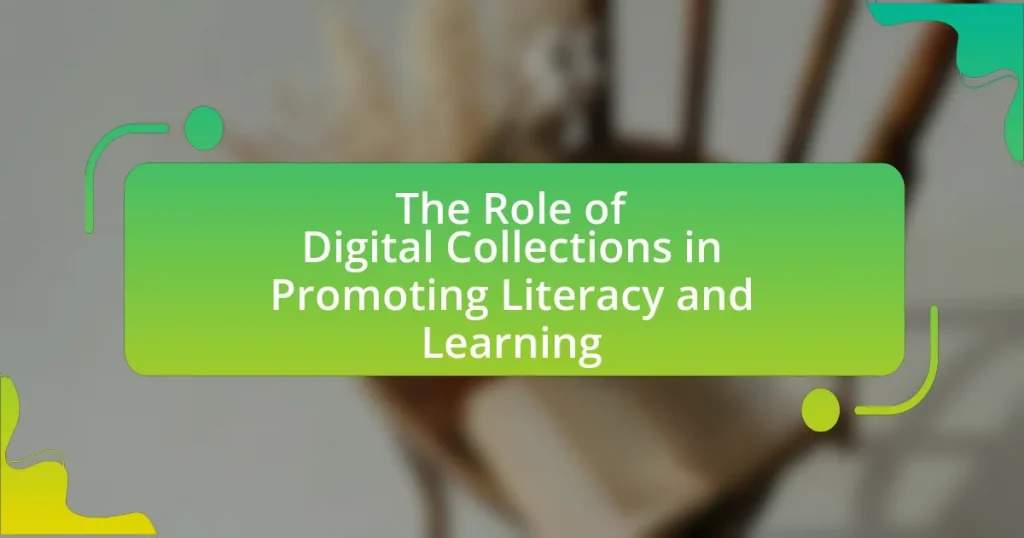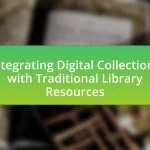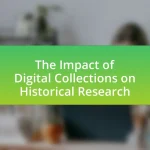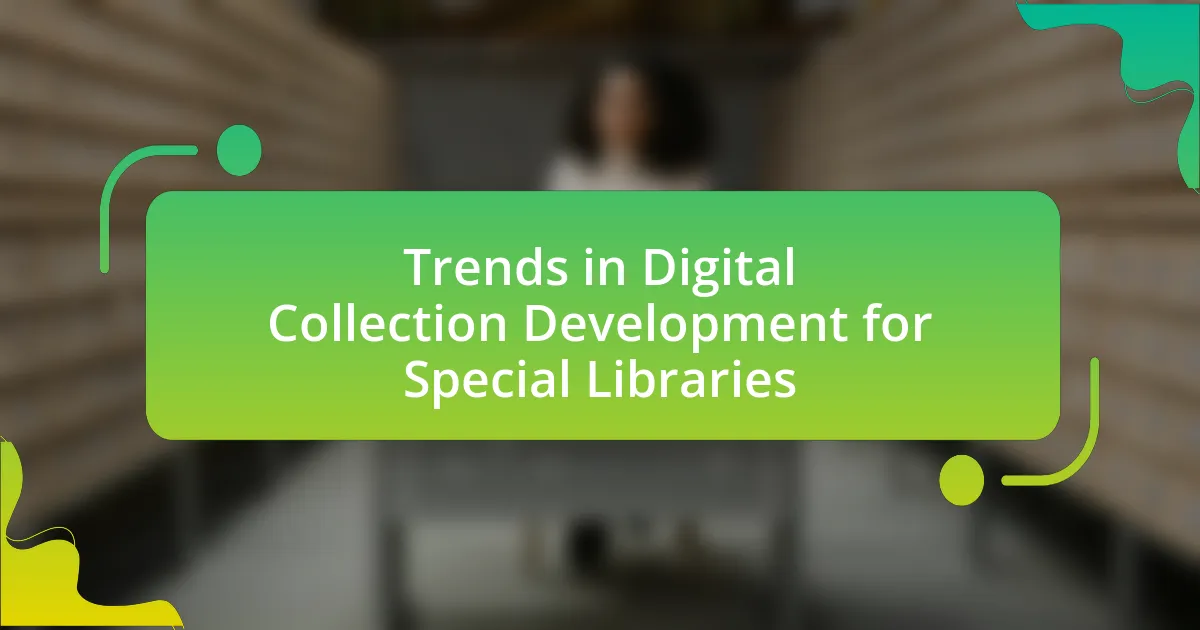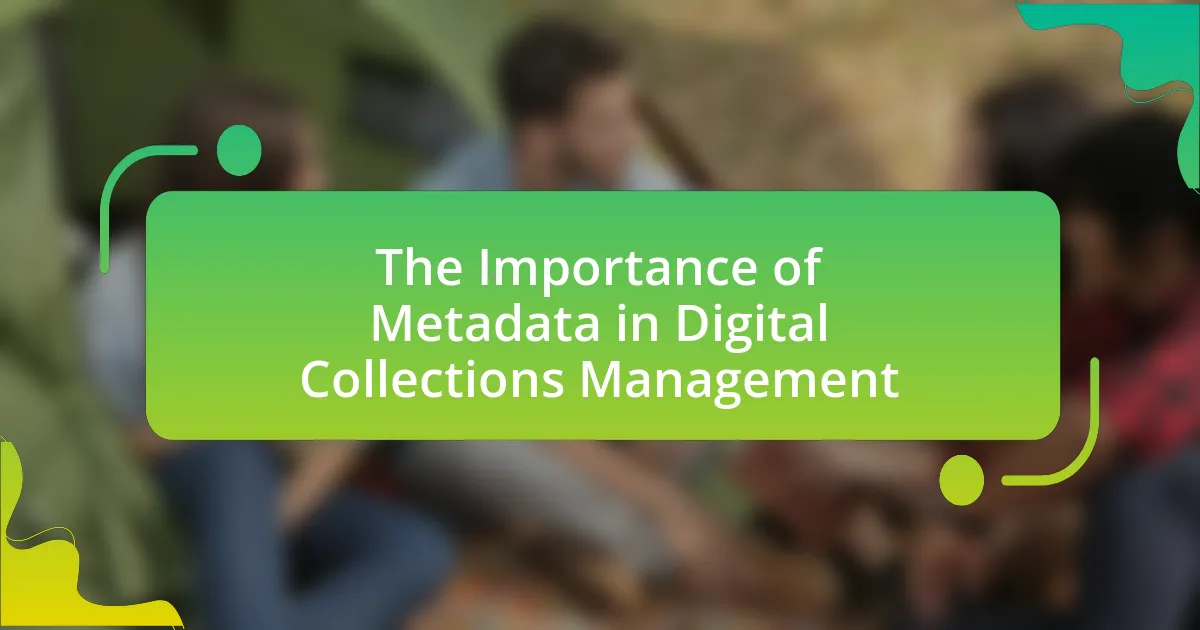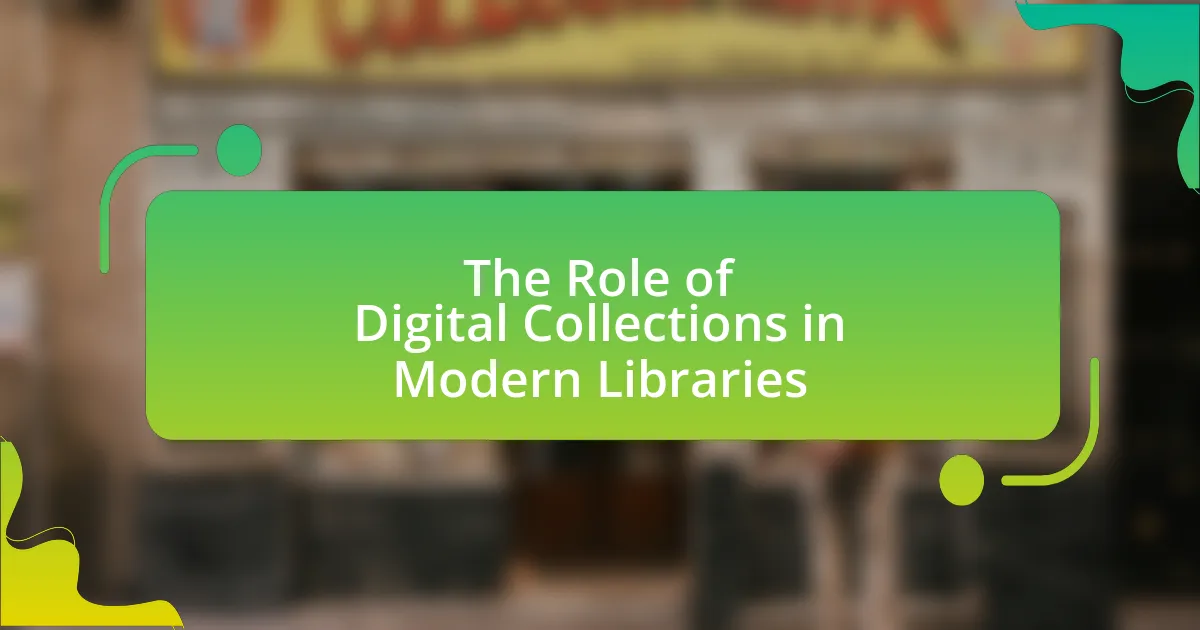Digital collections are curated groups of digital objects, including texts, images, audio, and video, that are accessible online for educational purposes. They play a crucial role in promoting literacy and learning by providing diverse resources that enhance student engagement, comprehension, and critical thinking skills. The article explores how digital collections support literacy development, cater to various learning styles, and foster interactive learning experiences. It also addresses the challenges faced in accessibility and digital literacy, while highlighting strategies for effective integration into educational settings. Additionally, the article discusses future trends and the impact of emerging technologies on digital collections in lifelong learning.
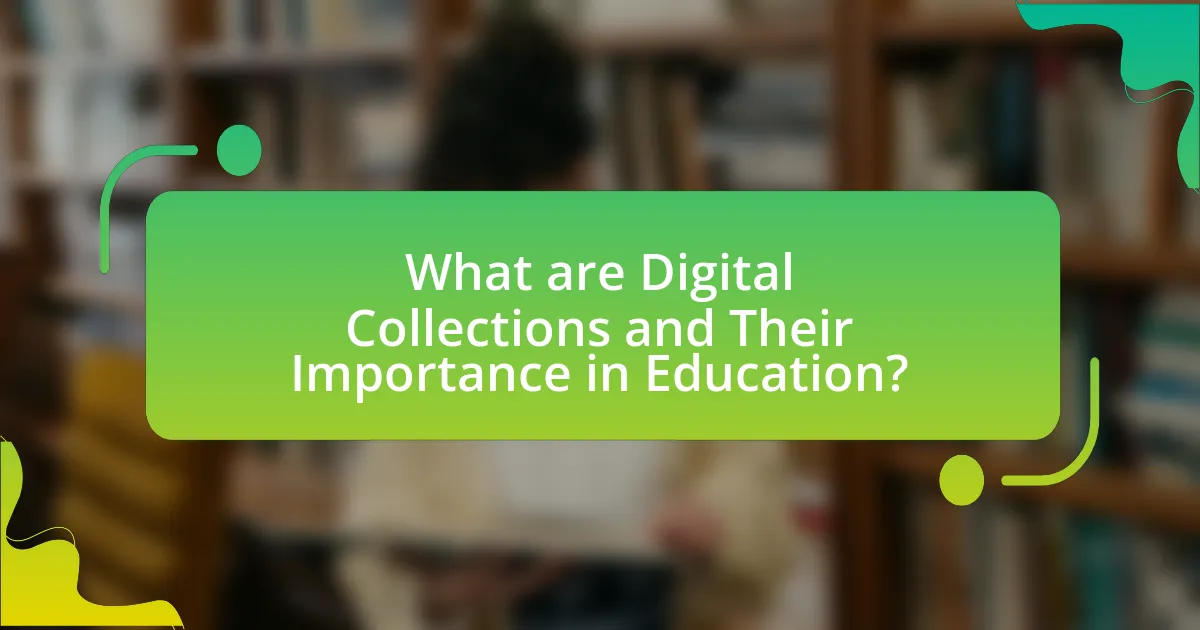
What are Digital Collections and Their Importance in Education?
Digital collections are curated groups of digital objects, such as texts, images, audio, and video, that are accessible online for educational purposes. Their importance in education lies in their ability to provide diverse resources that enhance learning experiences, promote literacy, and support research. For instance, studies show that access to digital collections can improve student engagement and comprehension by offering varied formats and perspectives, which cater to different learning styles. Additionally, digital collections often include primary sources that foster critical thinking and analytical skills, essential for academic success.
How do Digital Collections contribute to literacy development?
Digital collections contribute to literacy development by providing diverse, accessible resources that enhance reading and comprehension skills. These collections often include e-books, articles, and multimedia content, which cater to various learning styles and interests, thereby engaging a wider audience. Research indicates that access to a variety of texts improves vocabulary and critical thinking; for instance, a study by the National Literacy Trust found that children who engage with digital texts show higher levels of reading enjoyment and achievement. Furthermore, digital collections facilitate interactive learning experiences, allowing users to annotate, share, and discuss content, which reinforces understanding and retention of information.
What types of resources are typically found in Digital Collections?
Digital collections typically contain a variety of resources, including digitized books, manuscripts, photographs, audio recordings, videos, and archival materials. These resources are often curated to support research, education, and public engagement, providing access to historical documents and cultural artifacts. For instance, the Library of Congress offers a digital collection that includes over 14 million photographs, maps, and manuscripts, illustrating the breadth of materials available in such collections.
How do these resources support diverse learning styles?
Digital collections support diverse learning styles by providing a variety of formats and interactive elements that cater to different preferences. For instance, visual learners benefit from images and videos, auditory learners engage with podcasts and audiobooks, while kinesthetic learners can interact with digital simulations and hands-on activities. Research indicates that multimodal resources enhance comprehension and retention, as they allow learners to access information in ways that align with their individual learning preferences. This adaptability is crucial in educational settings, as it fosters inclusivity and encourages engagement among students with varying abilities and learning styles.
Why are Digital Collections essential for modern learning environments?
Digital collections are essential for modern learning environments because they provide accessible, diverse, and up-to-date resources that enhance educational experiences. These collections enable learners to engage with a wide range of materials, including e-books, articles, and multimedia content, fostering critical thinking and creativity. Research indicates that access to digital collections significantly improves literacy rates and information literacy skills among students, as they can explore various subjects and perspectives. For instance, a study by the Pew Research Center found that 87% of teachers believe that digital resources positively impact student engagement and learning outcomes.
What role do Digital Collections play in fostering critical thinking?
Digital Collections play a crucial role in fostering critical thinking by providing diverse resources that encourage analysis, evaluation, and synthesis of information. These collections offer access to a wide range of materials, including primary sources, multimedia content, and scholarly articles, which challenge users to engage with different perspectives and contexts. Research indicates that exposure to varied viewpoints enhances critical thinking skills, as users must assess credibility, identify biases, and draw informed conclusions based on evidence. For instance, a study by the American Association of Colleges and Universities found that students who engage with diverse digital resources demonstrate improved critical thinking abilities compared to those who rely on traditional texts alone.
How do they enhance access to information for learners?
Digital collections enhance access to information for learners by providing a vast array of resources that are easily searchable and available online. These collections often include e-books, articles, multimedia, and primary source documents, which learners can access anytime and anywhere, thus breaking geographical and temporal barriers. For instance, the Digital Public Library of America offers millions of photographs, manuscripts, and books, allowing users to explore diverse topics and perspectives that support their educational needs. This accessibility fosters independent learning and research skills, essential for academic success.

How do Digital Collections Promote Engagement and Interaction?
Digital collections promote engagement and interaction by providing accessible, diverse resources that encourage exploration and participation. These collections often include multimedia elements such as videos, images, and interactive tools that enhance user experience and foster deeper connections with the content. For instance, studies have shown that users are more likely to engage with digital collections that offer interactive features, such as virtual tours or gamified learning experiences, which can increase retention and understanding of the material. Additionally, digital collections facilitate community interaction through forums and social media integration, allowing users to share insights and collaborate, further enriching the learning experience.
What features of Digital Collections encourage user interaction?
Digital collections encourage user interaction through features such as search functionality, user-generated content, and multimedia elements. Search functionality allows users to easily locate specific items or information, enhancing engagement by making resources accessible. User-generated content, such as comments or reviews, fosters a sense of community and encourages users to share their insights, thereby increasing interaction. Multimedia elements, including videos, audio, and interactive graphics, provide diverse ways for users to engage with the material, catering to different learning styles and preferences. These features collectively enhance the user experience and promote active participation in digital collections.
How do multimedia elements enhance the learning experience?
Multimedia elements enhance the learning experience by engaging multiple senses, which facilitates better retention and understanding of information. Research indicates that learners who interact with multimedia content, such as videos, animations, and interactive simulations, demonstrate improved comprehension and recall compared to those who engage with text alone. For instance, a study published in the Journal of Educational Psychology found that students exposed to multimedia presentations scored significantly higher on assessments than those who received traditional lectures, highlighting the effectiveness of diverse formats in conveying complex concepts.
What tools are available for collaboration within Digital Collections?
Digital Collections offer various tools for collaboration, including shared workspaces, annotation features, and communication platforms. These tools enable users to collectively curate, annotate, and discuss digital materials, enhancing the collaborative experience. For instance, platforms like Omeka and CONTENTdm provide functionalities for group contributions and discussions, allowing multiple users to engage with the content simultaneously. Additionally, tools such as Google Docs and Slack can be integrated to facilitate real-time communication and document sharing among collaborators, further promoting effective teamwork in digital collection projects.
Why is accessibility a key factor in the effectiveness of Digital Collections?
Accessibility is a key factor in the effectiveness of Digital Collections because it ensures that diverse user groups, including those with disabilities, can access and utilize the resources available. When digital collections are designed with accessibility in mind, they can reach a wider audience, thereby enhancing engagement and promoting literacy and learning. For instance, according to the World Health Organization, approximately 15% of the global population experiences some form of disability, highlighting the necessity for inclusive design. Furthermore, research from the National Center on Accessible Media indicates that accessible digital content can improve learning outcomes for all users, not just those with disabilities, by providing multiple ways to engage with information. Thus, accessibility directly contributes to the overall impact and effectiveness of Digital Collections in educational contexts.
How do Digital Collections cater to learners with disabilities?
Digital collections cater to learners with disabilities by providing accessible formats and adaptive technologies that enhance their learning experience. These collections often include features such as screen reader compatibility, text-to-speech options, and customizable display settings, which accommodate various disabilities. For instance, the National Library Service for the Blind and Print Disabled offers digital audiobooks and braille materials, ensuring that visually impaired learners can access literature. Additionally, many digital collections adhere to the Web Content Accessibility Guidelines (WCAG), which set standards for making web content more accessible to individuals with disabilities. This commitment to accessibility not only supports diverse learning needs but also promotes inclusivity in educational environments.
What standards are in place to ensure accessibility in Digital Collections?
The standards in place to ensure accessibility in Digital Collections include the Web Content Accessibility Guidelines (WCAG), Section 508 of the Rehabilitation Act, and the Accessible Rich Internet Applications (ARIA) specifications. WCAG provides a comprehensive framework for making web content more accessible to individuals with disabilities, emphasizing principles such as perceivability, operability, understandability, and robustness. Section 508 mandates that federal agencies ensure their electronic and information technology is accessible to people with disabilities, thereby influencing digital collections in public institutions. ARIA enhances accessibility for dynamic web content, allowing developers to create more inclusive user experiences. These standards collectively promote equitable access to digital resources, facilitating literacy and learning for all users.
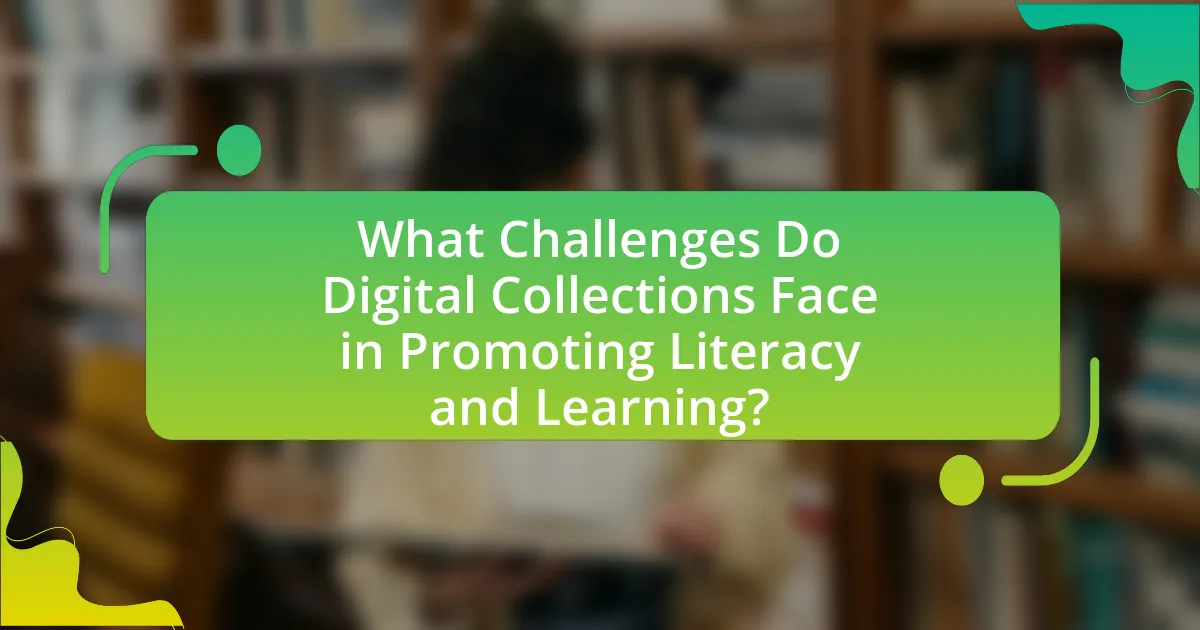
What Challenges Do Digital Collections Face in Promoting Literacy and Learning?
Digital collections face several challenges in promoting literacy and learning, primarily including accessibility, digital literacy, and content relevance. Accessibility issues arise when users lack the necessary technology or internet connectivity to access digital resources, limiting their ability to engage with the materials. According to a report by the Pew Research Center, approximately 15% of Americans do not use the internet, which directly impacts their access to digital collections.
Digital literacy is another significant challenge, as many users may not possess the skills required to navigate digital platforms effectively. A study by the National Assessment of Educational Progress found that only 21% of eighth graders demonstrated proficiency in digital literacy, indicating a gap that hinders effective use of digital collections for learning.
Finally, content relevance poses a challenge, as digital collections must continually update and curate materials that meet the diverse needs and interests of learners. Research from the International Society for Technology in Education highlights that outdated or irrelevant content can disengage users and diminish the educational value of digital collections.
What are the common barriers to accessing Digital Collections?
Common barriers to accessing digital collections include limited internet access, lack of digital literacy, and inadequate technological resources. Limited internet access affects individuals in rural or underserved areas, making it difficult to retrieve online materials. Lack of digital literacy prevents users from effectively navigating and utilizing digital platforms, which is essential for accessing these collections. Additionally, inadequate technological resources, such as outdated devices or software, hinder users’ ability to engage with digital content. According to a report by the Pew Research Center, approximately 25% of adults in the U.S. do not have high-speed internet access, highlighting the significant impact of connectivity on access to digital collections.
How does digital literacy impact the use of Digital Collections?
Digital literacy significantly enhances the use of digital collections by enabling users to effectively locate, evaluate, and utilize digital resources. Users with strong digital literacy skills can navigate various platforms, discern credible information, and engage with diverse formats, which increases their ability to access and benefit from digital collections. Research indicates that individuals with higher digital literacy are more likely to utilize online databases and digital archives, as they possess the skills necessary to search efficiently and critically assess the information they find. For instance, a study by the Pew Research Center found that 87% of adults with advanced digital skills reported using online libraries and archives compared to only 45% of those with basic skills. This demonstrates that digital literacy directly correlates with the frequency and effectiveness of engagement with digital collections.
What strategies can be implemented to overcome these barriers?
To overcome barriers in promoting literacy and learning through digital collections, strategies such as enhancing accessibility, providing targeted training, and fostering community partnerships can be implemented. Enhancing accessibility involves ensuring that digital collections are user-friendly and available across various devices, which can increase engagement among diverse user groups. Providing targeted training equips educators and learners with the necessary skills to effectively utilize digital resources, thereby improving their literacy outcomes. Fostering community partnerships can create a support network that encourages collaboration between libraries, schools, and local organizations, facilitating broader access to digital collections and resources. These strategies are supported by research indicating that increased accessibility and community involvement significantly enhance educational outcomes and literacy rates.
How can educators effectively integrate Digital Collections into their teaching?
Educators can effectively integrate Digital Collections into their teaching by aligning digital resources with curriculum objectives and utilizing them to enhance student engagement and critical thinking. For instance, educators can select specific digital artifacts that relate to historical events or literary themes, allowing students to analyze primary sources and develop research skills. Studies show that using digital collections can improve literacy outcomes; for example, a report by the National Endowment for the Humanities indicates that access to diverse digital materials fosters deeper comprehension and analytical abilities in students. By incorporating these resources into lesson plans, educators can create interactive learning experiences that promote inquiry-based learning and collaboration among students.
What best practices should educators follow when using Digital Collections?
Educators should prioritize accessibility, relevance, and engagement when using Digital Collections. Ensuring that digital resources are accessible to all students, including those with disabilities, is crucial for inclusive learning. Selecting materials that are relevant to the curriculum enhances student interest and promotes deeper understanding. Additionally, incorporating interactive elements, such as multimedia and collaborative projects, fosters engagement and encourages critical thinking. Research indicates that using diverse formats in digital collections can improve literacy skills, as highlighted in the study “Digital Literacy: A Conceptual Framework” by the International Society for Technology in Education, which emphasizes the importance of varied resources in enhancing learning outcomes.
How can assessment methods be adapted to include Digital Collections?
Assessment methods can be adapted to include Digital Collections by integrating digital resources into evaluation criteria and utilizing technology for data collection and analysis. This adaptation allows educators to assess students’ engagement with digital materials, such as e-books, online databases, and multimedia resources, which can enhance literacy and learning outcomes. For instance, assessments can incorporate tasks that require students to analyze, synthesize, and present information from digital collections, thereby fostering critical thinking and digital literacy skills. Research indicates that incorporating digital resources in assessments can lead to improved student performance and engagement, as evidenced by studies showing that students who interact with diverse digital formats demonstrate higher levels of comprehension and retention.
What are the future trends for Digital Collections in education?
Future trends for digital collections in education include increased integration of artificial intelligence for personalized learning experiences, enhanced accessibility features for diverse learners, and the expansion of collaborative platforms that facilitate shared resources among educators and students. These trends are driven by the growing demand for tailored educational content and the need for inclusive learning environments. For instance, a report by the International Society for Technology in Education highlights that 70% of educators believe AI will significantly impact personalized learning by 2025, indicating a strong shift towards technology-enhanced educational practices.
How might emerging technologies influence Digital Collections?
Emerging technologies significantly influence digital collections by enhancing accessibility, interactivity, and preservation. For instance, advancements in artificial intelligence enable more efficient cataloging and retrieval of digital assets, allowing users to find relevant materials quickly. Additionally, augmented reality and virtual reality technologies create immersive experiences that engage users in new ways, fostering deeper learning and literacy. According to a study by the Pew Research Center, 73% of educators believe that technology positively impacts student engagement, highlighting the role of these innovations in promoting literacy through digital collections.
What role will Digital Collections play in lifelong learning?
Digital Collections will serve as essential resources for lifelong learning by providing accessible, diverse, and up-to-date information across various subjects. These collections enable individuals to engage with a wide range of materials, including e-books, articles, and multimedia content, which support self-directed learning and skill development. Research indicates that access to digital resources enhances knowledge retention and fosters critical thinking, as users can explore topics at their own pace and according to their interests. Furthermore, studies show that digital collections can bridge educational gaps by offering resources to underserved communities, thereby promoting equity in learning opportunities.
What practical tips can enhance the use of Digital Collections for literacy and learning?
To enhance the use of Digital Collections for literacy and learning, educators should integrate interactive elements such as quizzes and discussion forums within the collections. These features promote engagement and critical thinking, which are essential for effective learning. Research indicates that interactive learning environments can improve retention rates by up to 25% (Freeman et al., 2014, Proceedings of the National Academy of Sciences). Additionally, providing guided access to curated resources helps learners navigate vast digital collections, ensuring they focus on relevant materials that align with their literacy goals. This structured approach can lead to a more meaningful learning experience, as evidenced by studies showing that guided instruction significantly boosts comprehension and application of knowledge (Hattie, 2009, Visible Learning).
